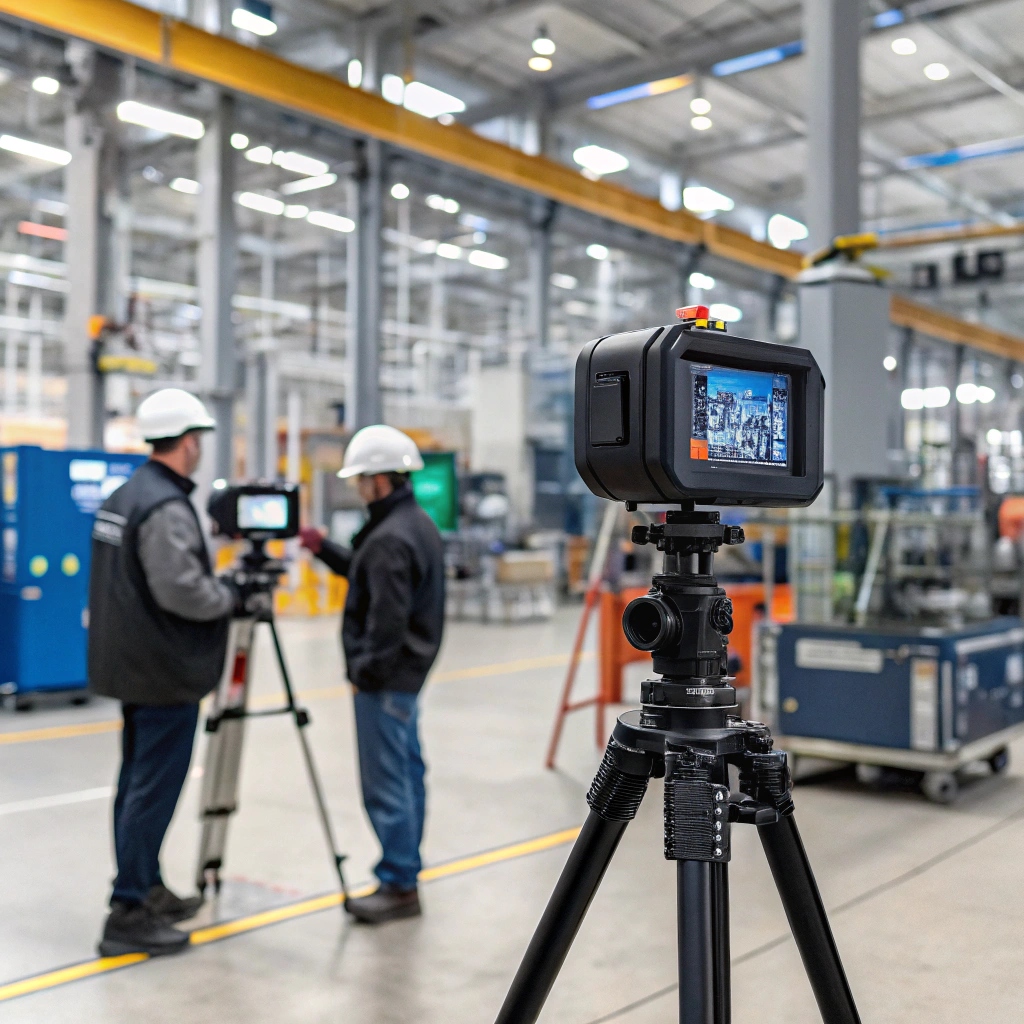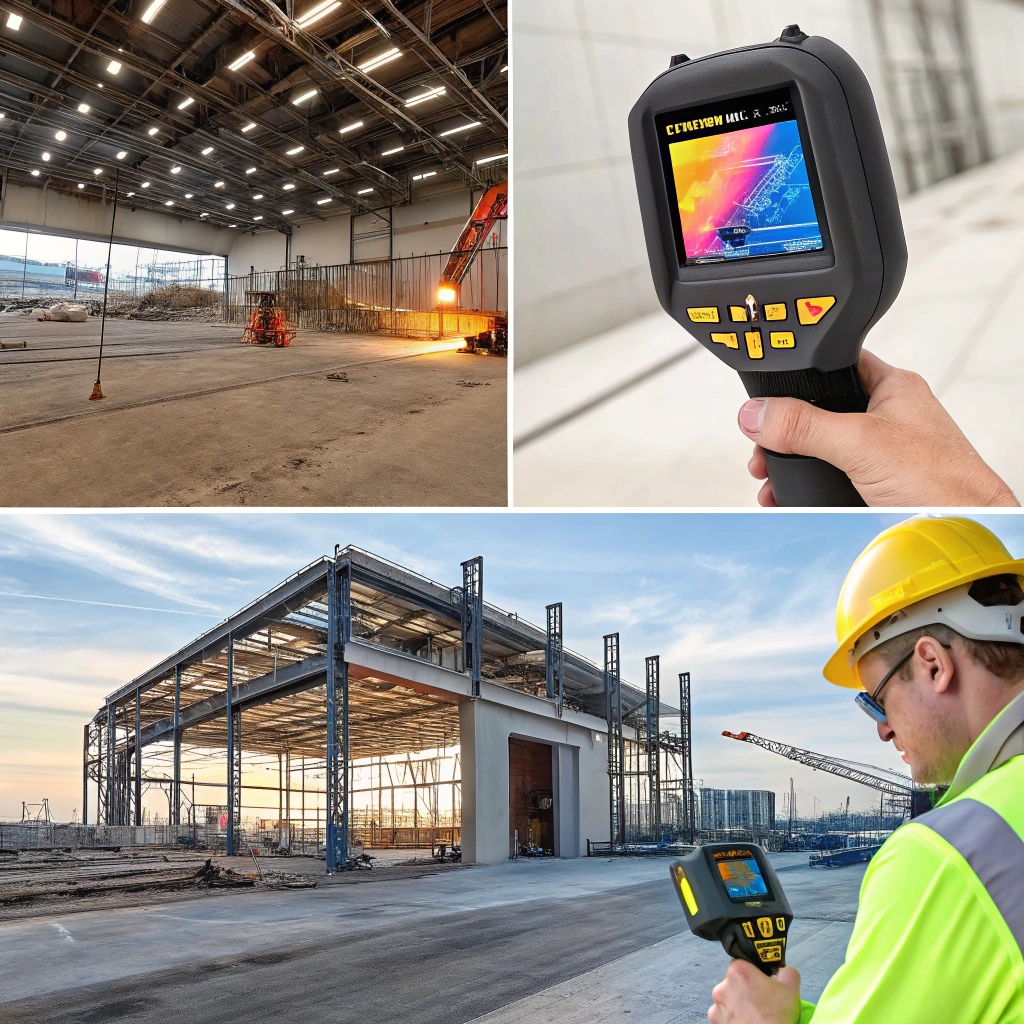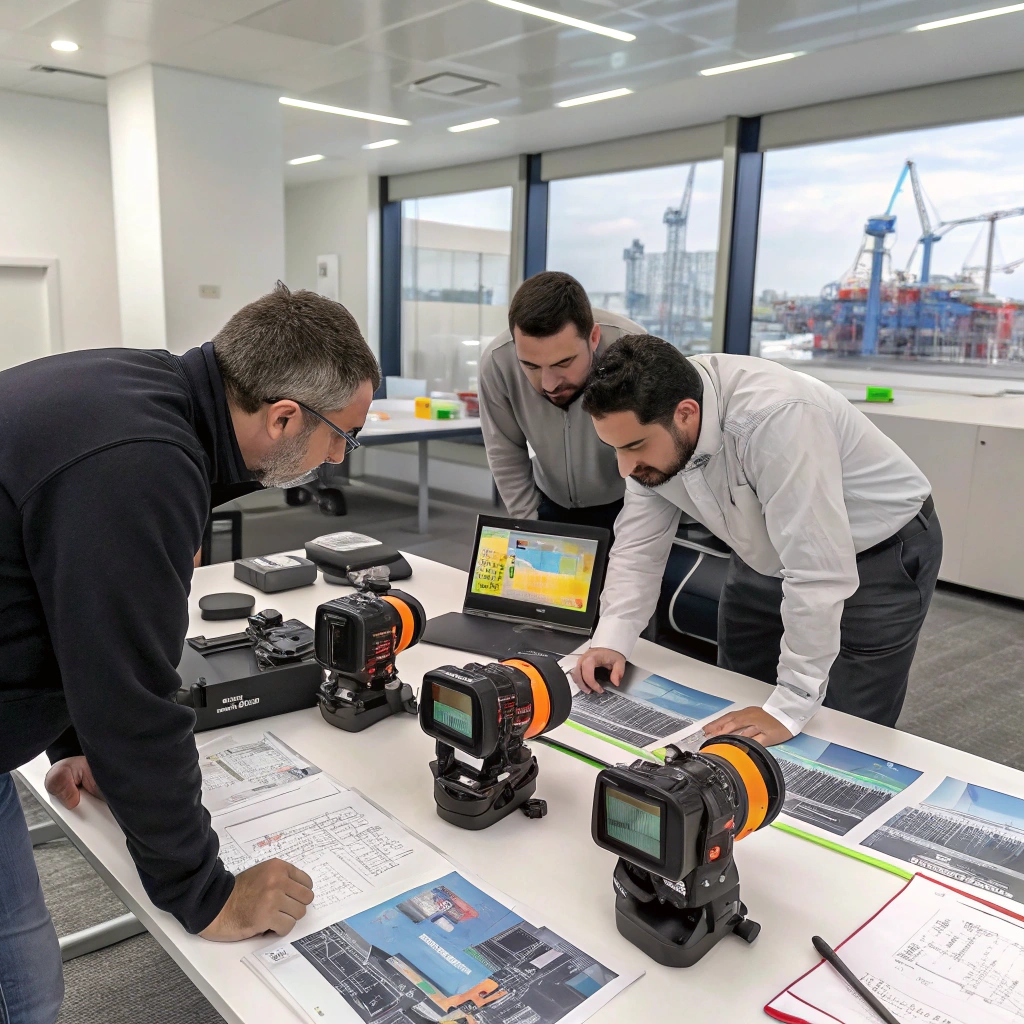Applications of Thermal Cameras in Industry
Thermal cameras are revolutionising industries with their ability to detect infrared radiation. They convert this radiation into images, revealing heat patterns invisible to the naked eye.
These cameras are invaluable tools across various sectors. From construction to manufacturing, they enhance efficiency and safety.
In construction, they identify heat leaks and insulation issues, saving energy and costs. Electricians use them to spot overheating components, preventing potential failures.
Plumbers can easily locate leaks and blockages in pipes using thermal imaging. Manufacturing industries rely on them for quality control and equipment maintenance.
Firefighters use thermal cameras to see through smoke and locate hotspots, crucial for saving lives. In the medical field, they offer non-invasive diagnostic options.
The technology is advancing, making thermal cameras more affordable and accessible. This article explores the diverse applications of thermal cameras in industry.

Understanding Thermal Imaging Technology
Thermal imaging technology involves the detection and visualisation of infrared radiation. All objects emit infrared radiation as a function of their temperature. Thermal cameras capture this radiation and convert it to a visible image, highlighting temperature differences.
The core component of a thermal camera is the sensor, which detects infrared radiation. Advanced software then processes the detected energy and creates a thermal image. These images show heat patterns and temperatures, using colors to represent different temperatures.
Key advantages of thermal imaging include non-contact measurement1 and identification of heat anomalies. This makes it suitable for hard-to-reach or hazardous areas.
Main features of thermal cameras include:
- Resolution: Determines image detail quality.
- Sensitivity: Detects slight temperature variations.
- Temperature Range: Suitability for various applications.
- Portability: Cameras come in handheld or stationary models.
The understanding of these features helps in choosing the right camera for specific industrial needs. As technology improves, thermal imaging continues to find new applications, providing indispensable insights and maintaining operational safety.
Key Types of Thermal Cameras and Their Features
Various types of thermal cameras cater to different industrial needs. Understanding the distinctions is crucial for selecting the right device. Some cameras offer more features and better resolution, while others focus on portability and cost-effectiveness.
Handheld thermal cameras are popular for their mobility and ease of use. These models provide flexibility in various inspection environments. They are essential for professionals who move frequently during inspections.
For detailed thermal images, high-resolution thermal cameras2 are preferred. They provide clearer images for precise temperature analysis. These cameras are ideal in environments where detail is critical, such as research or development.
Mini infrared cameras3 offer solutions for tight spaces or discreet monitoring. Their compact design allows them to fit where larger models can’t. They are well-suited for specialised applications or confined environments.
Key features when considering a thermal camera include:
- Portability: Determines usability in the field.
- Resolution: Affects image clarity and detail.
- Field of View: Influences the coverage area.
Selecting a thermal camera involves balancing these features against specific application requirements and budget constraints. Whether for construction, manufacturing, or another industry, the right camera can greatly enhance efficiency and safety.
Industrial Applications of Thermal Cameras
Thermal cameras have revolutionised several industries by enhancing efficiency and safety. They detect infrared radiation, converting it to visual images. This allows unseen temperature variations to be easily identified.
Key industrial applications include:
- Construction and Building Inspections
- Electrical and Mechanical Maintenance
- Plumbing and Water Leak Detection
As technology advances, these applications expand, offering new solutions. The diverse uses illustrate the adaptability and necessity of thermal imaging in modern industries.

Construction and Building Inspections
In construction, thermal cameras play a vital role. They help identify insulation issues, heat leaks, and moisture intrusion. This technology ensures buildings meet energy efficiency standards.
Inspectors rely on thermal cameras for detecting hidden defects. These could include unseen mold growth or air leaks. Builders use thermal imaging to verify that installations meet safety codes.
Modern construction incorporates thermal inspections in routine checks. By detecting issues early, contractors can save costs on repairs later. Building owners benefit from improved safety and reduced energy bills.
Common uses in construction include:
- Inspecting insulation levels
- Detecting air leaks around windows and doors
- Identifying moisture or water leaks
Thermal technology in construction is crucial for ensuring quality and compliance. It supports sustainable building practices by improving energy efficiency.
Electrical and Mechanical Maintenance
Thermal imaging is essential in electrical maintenance. Electricians use it to locate hotspots in wiring, preventing potential failures. Early detection of overheating components can avert costly downtimes.
In mechanical systems, thermal cameras highlight wear and tear. They identify friction points, overheating motors, and misaligned components. Maintenance teams use this data to keep equipment running smoothly.
Preventive maintenance with thermal imaging reduces unexpected failures. It also extends the life of machinery. This proactive approach leads to increased safety and reliability in operations.
Key applications include:
- Identifying faulty electrical connections
- Monitoring motor and bearing temperatures
- Detecting abnormal heating in circuits
By integrating thermal cameras, industries enhance both performance and safety. This results in more efficient and durable equipment.
Plumbing and Water Leak Detection
Plumbers benefit greatly from thermal imaging technology. It helps pinpoint leaks, reducing the need for invasive inspections. By detecting temperature changes, cameras reveal the presence of water.
This approach minimises damage when locating problems. It also accelerates repair timelines. Plumbers can quickly identify blockages, thanks to precise thermal imaging.
The technology is useful in both residential and commercial settings. It simplifies complex plumbing diagnostics. This technological edge allows plumbers to provide effective solutions.
Common applications include:
- Detecting pipe blockages
- Locating hidden leaks behind walls
- Assessing pipe insulation
Overall, thermal imaging enhances accuracy and efficiency in plumbing. It supports better service delivery and reduces customer disruptions.
Manufacturing and Quality Control
In manufacturing, thermal cameras ensure quality and consistency. They monitor heat distribution in production processes. This prevents defects and improves product reliability.
Production lines benefit from thermal imaging through real-time monitoring. It allows for quick adjustments, ensuring optimal conditions. This leads to enhanced manufacturing efficiency.
Quality control checks also rely on thermal cameras. These tools detect defective items before they reach the market. This reduces waste and maintains high customer satisfaction.
Key uses in manufacturing include:
- Quality control inspections
- Monitoring thermal profiles during production
- Detecting overheating equipment
Thermal imaging stands at the forefront of modern manufacturing. It drives quality and enhances product integrity.
Oil, Gas, and Energy Sector
Thermal imaging offers significant benefits in the oil and gas industry. It helps in detecting leaks, ensuring environmental safety. Cameras identify changes in temperature patterns around pipelines and equipment.
Thermal technology also aids in energy audits. It provides insights into heat loss, enhancing efficiency. This is crucial for both sustainability and cost reduction.
Energy sector applications include:
- Identifying pipeline leaks
- Monitoring equipment temperatures
- Conducting energy efficiency audits4
With thermal cameras, the industry minimises risks. It also secures operations while promoting environmental responsibility.
Firefighting and Emergency Services
Firefighters use thermal imaging to locate hotspots. Cameras see through smoke, providing critical insights. This improves safety and aids in the quick extinguishing of fires.
Thermal cameras also help find victims in low visibility conditions. They are vital tools for saving lives. Their use streamlines operations in emergency scenarios.
Applications include:
- Identifying hotspots
- Locating victims in smoke-filled environments
Ultimately, thermal imaging enhances efficiency in emergency services. It stands as an essential tool for firefighters worldwide.
Medical and Pharmaceutical Applications
In the medical field, thermal imaging aids in non-invasive diagnostics5. It detects abnormal heat patterns, indicating potential health issues. This technology supports early intervention.
In pharmaceuticals, thermal cameras monitor processes. They ensure quality by detecting temperature variances. This precision is key in creating consistent and safe products.
Applications include:
- Non-invasive medical diagnostics
- Process monitoring in pharmaceuticals
Thermal imaging in medicine promotes proactive care. It ensures higher quality standards in pharmaceuticals.
Agriculture and Environmental Monitoring
Thermal cameras are used in agriculture to monitor crop health. They detect temperature shifts indicating water stress. This assists in precision farming techniques.
Environmentalists use thermal imaging to study ecosystems. It provides insights into animal behaviour and habitat conditions. This information aids in conservation efforts.
Key applications include:
- Monitoring crop temperature and water stress
- Observing wildlife and habitats
Thermal imaging supports sustainable agriculture. It also advances environmental research and preservation.
Security, Surveillance, and Law Enforcement
Security and law enforcement make extensive use of thermal cameras. These devices detect intruders by identifying heat signatures. It enhances night-time security operations.
Thermal technology also assists in forensic investigations. It reveals details invisible to the naked eye. This aids law enforcement in case resolution.
Common applications include:
- Detecting intruders in security zones
- Forensic analysis in investigations
Thermal imaging strengthens security frameworks. It aids both preventive and investigative operations.
Research, Aerospace, and Automotive Industries
In research and development, thermal cameras provide data for temperature analysis. They support studies requiring precise thermal measurements. This aids in various scientific advancements.
The aerospace industry uses thermal imaging to inspect aircraft structures. It detects anomalies that could affect safety. This technology is also employed in automotive testing and diagnostics.
Applications include:
- Thermal analysis in research projects
- Structural inspections in aerospace
- Diagnostics in automotive manufacturing
Thermal cameras fuel innovation across several sectors. They provide essential insights that drive technological progress.
Choosing the Right Thermal Camera for Your Industry
Selecting the right thermal camera depends on specific industry needs. Evaluate the features and capabilities each device offers. Factors such as resolution, range, and portability are crucial.
High-resolution thermal cameras6 provide detailed imaging. They are ideal for industries requiring precise analysis. Conversely, a budget thermal imaging camera7 may suffice for simpler tasks.
Consider the following when choosing a thermal camera:
- Resolution and image clarity
- Ease of use and portability
- Cost and budget constraints
Matching a thermal camera’s features to your industry needs optimises performance. Whether for detailed inspections or basic monitoring, the right choice maximises efficiency and value. This ensures you get the most out of your investment in thermal imaging technology.

Cost Considerations: How Much Does a Thermal Imaging Camera Cost?
Thermal camera costs vary widely based on resolution and features. Basic models are quite affordable, suited for less demanding tasks. On the other hand, high-end devices can be significant investments.
When budgeting, consider the following cost factors:
- Camera resolution and image quality
- Advanced features and software capabilities
- Brand reputation and support
Investing in a thermal camera with the right balance of cost and features ensures value. Understanding these factors can help you make a well-informed purchasing decision.
Future Trends and Innovations in Thermal Imaging
The thermal imaging field is rapidly evolving with technological advancements. Innovations are driven by the demand for improved accessibility and functionality. This growth makes thermal cameras increasingly versatile across industries.
Emerging trends and innovations include:
- Integration with AI for smarter detection and analysis8
- Enhanced resolution at more affordable prices
- Compact and lightweight designs for greater portability
These developments promise even broader applications, ensuring thermal imaging remains a vital tool for industry professionals. As technology progresses, the potential for new and exciting uses will only increase.
Conclusion: Maximising Value with Thermal Imaging in Industry
Thermal imaging has become indispensable in various industries. Its applications continue to expand, offering critical insights and efficiencies.
Industry professionals who leverage thermal camera technology will gain significant advantages. By choosing the right equipment and staying informed on innovations, they can maximise value and drive operational success.
-
Understanding the advantages of non-contact measurement can help you appreciate its significance in safety and efficiency. ↩
-
Learn why high-resolution thermal cameras are crucial for precise temperature analysis in critical environments. ↩
-
Discover how mini infrared cameras can be utilized in confined environments for discreet monitoring and specialized applications. ↩
-
Learn how energy efficiency audits with thermal cameras can significantly reduce costs and enhance sustainability in operations. ↩
-
Discover the benefits of non-invasive diagnostics in healthcare, improving patient care and early detection of health issues. ↩
-
Explore how high-resolution thermal cameras can enhance precision and efficiency in various industries, ensuring you make an informed choice. ↩
-
Learn about the essential features and limitations of budget thermal imaging cameras to make a smart purchasing decision. ↩
-
Explore how AI enhances thermal imaging capabilities, making detection smarter and more efficient for various applications. ↩
